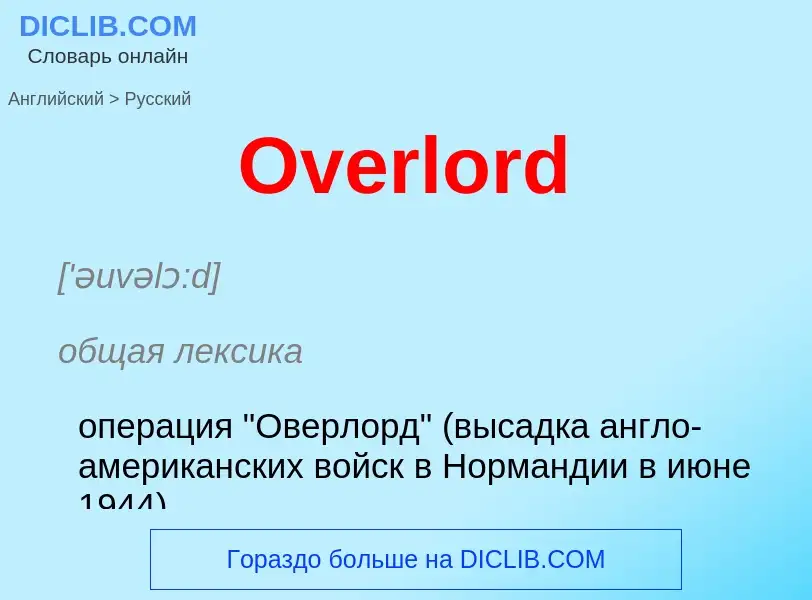Translation and analysis of words by ChatGPT artificial intelligence
On this page you can get a detailed analysis of a word or phrase, produced by the best artificial intelligence technology to date:
- how the word is used
- frequency of use
- it is used more often in oral or written speech
- word translation options
- usage examples (several phrases with translation)
- etymology
Overlord - translation to russian
['əuvəlɔ:d]
общая лексика
операция "Оверлорд" (высадка англо-американских войск в Нормандии в июне 1944)
дословная передача
повелитель
синоним
['əuvəlɔ:d]
существительное
[əuvə'lɔ:d]
общая лексика
сюзерен
владыка
повелитель
господин
верховный владыка
повелитель, господин
глагол
общая лексика
господствовать
доминировать
Definition
Wikipedia

An overlord in the English feudal system was a lord of a manor who had subinfeudated a particular manor, estate or fee, to a tenant. The tenant thenceforth owed to the overlord one of a variety of services, usually military service or serjeanty, depending on which form of tenure (i.e. feudal tenancy contract) the estate was held under. The highest overlord of all, or paramount lord, was the monarch, who due to his ancestor William the Conqueror's personal conquest of the Kingdom of England, owned by inheritance from him all the land in England under allodial title and had no superior overlord, "holding from God and his sword", although certain monarchs, notably King John (1199–1216) purported to grant the Kingdom of England to Pope Innocent III, who would thus have become overlord to English monarchs.
A paramount lord may then be seen to occupy the apex of the feudal pyramid, or the root of the feudal tree, and such allodial title is also termed "radical title" (from Latin radix, root), "ultimate title" and "final title". William the Conqueror immediately set about granting tenancies on his newly won lands, in accordance with feudal principles. The monarch's immediate tenants were the tenants-in-chief, usually military magnates, who held the highest status in feudal society below the monarch. The tenants-in-chief usually held multiple manors or other estates from the monarch, often as feudal barons (or "barons by tenure") who owed their royal overlord an enhanced and onerous form of military service, and subinfeudated most to tenants, generally their own knights or military followers, keeping only a few in demesne. This created a mesne lord – tenant relationship. The knights in turn subinfeudated to their own tenants, creating a further subsidiary mesne lord – tenant relationship. Over the centuries for any single estate the process was in practice repeated numerous times.
In early times, following the Norman Conquest of England of 1066 and the establishment of feudalism, land was usually transferred by subinfeudation, rarely by alienation (i.e. sale), which latter in the case of tenants-in-chief required royal licence, and the holder of an estate at any particular time, in order to gain secure tenure, and if challenged by another claimant, needed to prove "devolution of title" evidenced by legal deeds or muniments back up the chain of subinfeudations to a holder whose title was beyond doubt, for example one who had received the estate as a grant by royal charter witnessed and sealed by substantial persons. Although feudal land tenure in England was abolished by the Tenures Abolition Act 1660, in modern English conveyancing law the need to prove devolution of title persisted until recent times, due to a "legal fiction" (grounded in reality) that all land titles were held by the monarch's subjects as a result of a royal grant. Proving devolution of title is no longer necessary since the creation of the land registry. There is a requirement to compulsorily register all land transactions on this governmental record, which registration provides a virtually unchallengeable and perfectly secure title of ownership.

![William]] as his overlord for the territory of the [[Kingdom of England]], which relationship he broke by having himself crowned King. It is thus central to the [[Norman conquest of England]] William]] as his overlord for the territory of the [[Kingdom of England]], which relationship he broke by having himself crowned King. It is thus central to the [[Norman conquest of England]]](https://commons.wikimedia.org/wiki/Special:FilePath/Bayeux Tapestry scene23 Harold sacramentum fecit Willelmo duci.jpg?width=200)
